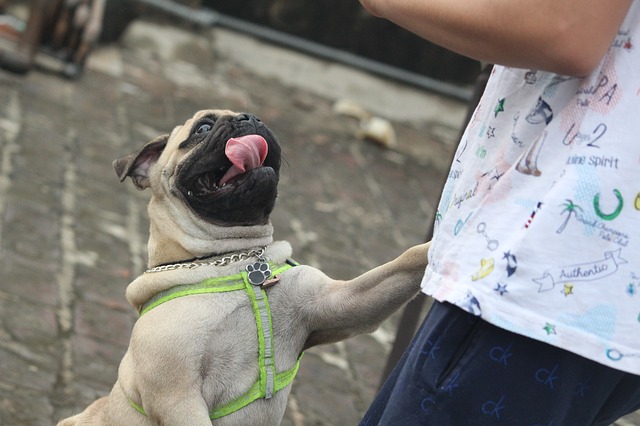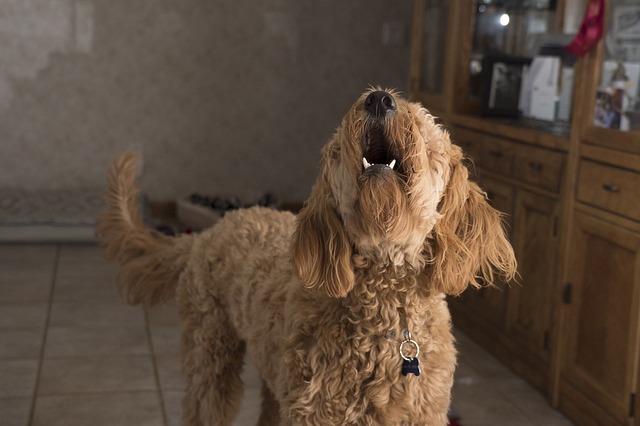Being a little mischievous is part of being a dog, and for the most part, behavioral issues can be addressed with the right kind of training. There are instances, however, when dog owners accidentally encourage their dogs to pick up bad habits. These undesired behaviors develop slowly until they’re second nature for the dog. There’s no such thing as a point of no return, but it’s definitely harder to break a dog’s bad habits than it is to teach good habits right from the start.
The sooner you realize you’re teaching your pup poor manners, the sooner you can change their behavior for the better. Countless dog owners don’t realize they’re accidentally teaching their dogs to do these four things.

1. Begging for Scraps
We all know what it feels like to be deemed powerless by a pair of puppy dog eyes. They’re so persuasive, a stare down can end up costing you most of the food on your dinner plate. Giving in to your dog’s plea for food, however, will start a long spiral of begging behavior. Once the dog figures out your weakness, they won’t hesitate to take advantage of it. Tossing them food from your plate reinforces the idea that begging gets them what they want. Soon they’ll move on to more intrusive behaviors like invading your personal space when you’re trying to eat and stealing food right from your fingers.
You can’t blame your dog for the behavior because you’re the one that inadvertently taught it to them. If you’ve got a beggar on your hands, it’s time to stop giving in. Jim Burwell’s Petiquette Dog Training says,
“Avoid paying attention to or looking at your dog when you are eating. Paying attention to your dog will encourage the begging. You are setting him up to expect something.”
You can also try engaging your dog in other activities while you eat. Give them their own meal or if your dog knows a “place” command, have them spend the entirety of your mealtime at their place. If your dog knows “go to your mat,” for example, have your dog go to their mat and stay there instead of crowding the table. When your meal is finished, reward your dog’s good behavior with a treat while they’re still on their mat.
2. Jumping for Joy
A dog jumping on you to say hello can almost be seen as a compliment. It means they’re overjoyed to see you, and who doesn’t love being on the receiving end of a dog’s affection? That mindset is exactly why countless dogs develop the bad habit of jumping on people they meet. Their owners think it’s adorable and funny, and dog people most often respond by laughing and giving the dog plenty of pets. That type of reaction serves as positive reinforcement and teaches the dog that jumping is a good thing.

Some people excuse their dog’s behavior because either their dog is too small to do any real damage or because they secretly enjoy the attention. But jumping on people is problematic behavior for several reasons. First, not everyone is going to appreciate your dog putting their paws on them. Big or small, overenthusiastic dogs can be intimidating to your friends and family not used to being around dogs. There’s also the issue of it being dangerous. If your large dog jumps on an elderly person, they could easily knock them down and cause a serious injury. The same thing can happen to kids.
Instead of encouraging the behavior by giving your dog a reaction, you deter jumping by not reacting at all. Your dog jumps because they think it’ll give them what they want, which is the person’s attention. Instead of laughing or scolding, do the opposite of what your dog wants. That means you turn away and ignore them. Wait until all four paws are on the floor before going in for the greeting. If they jump again, turn around again. When you have guests over, it’s best to keep your jumping pup on a leash until they break the habit.
3. Whining/Barking for Attention
Dogs bark when they’re happy, whine when they’re scared and make weird growling sounds when they’re excited. That’s all fine, but some dogs develop the habit of making noise to boss people around. Examples of this behavior are when your dog barks at you when they know it’s their dinner time. Some dogs also whine to get a person’s attention or bark when they’re tired of being in their crate. A lot of dog owners comply to demand barking or whining because it’s the fastest way to make them be quiet. But at the same time, giving in teaches the dog to keep doing it. Soon, your dog will bark every time they want something.
If demand barking is already a problem in your house, start retraining your dog to ask for things more politely. Sitting is a good replacement behavior. Instead of barking when they’re hungry, teach your dog to sit quietly next to their food bowl. When they want to go outside, teach them you won’t open the door until they sit nicely.
While you’re busy training this new behavior, you’ll also have to un-train the old one. PetMd says,
“If you’re prepping his dinner and he “yells” at you to hurry up, put his dog bowl down and walk away. If he barks at you to throw the ball, drop it and do something else. Your dog will soon learn that barking makes you do the opposite of what he wants.”

4. Pulling During Walks
Pulling on the leash starts as innocent puppy enthusiasm, but if you’re not careful, you’ll end up dreading every walk. Little dogs are big offenders of pulling because their owners let them get away with it. But if their leash is attached to their collar, it only takes one yank to injure their small neck bones. For large dogs, pulling is especially problematic because of their size and strength. Big breeds can easily pull a person off their feet, and walks are no fun when it feels like your arm is being pulled from its socket. Start enjoying time spent with your dog by changing the way you walk.
Every time you take a step forward when your dog is pulling on the leash, you encourage them to keep on pulling. Eventually, they get the idea that tension on the leash means they move forward faster. You have to change that belief by putting in significant time and effort to leash training.
Resign yourself to the fact that until your dog learns their leash manners, you won’t be going very far on your walks. That’s because every time your dog puts tension on the leash, you need to stop moving. Don’t pull back, don’t yank the leash, and don’t yell. Instead, encourage your dog to slacken the leash by calling their name and holding out a treat. As soon as the leash slackens, give them the treat and start walking. If they pull again, repeat the process. The first couple tries you’ll probably only make it a few steps in the same amount of time you’d normally walk around the block. It’ll require extreme patience, but walking nicely on leash is a lesson all dogs need to learn.
Both humans and dogs make occasional mistakes, and these four training mix ups are common for all dog owners. If you just realized you’ve been encouraging your dog to behave badly, don’t panic. All of these bad habits can be broken if you commit to training. All you need to do is get serious about improving your dog’s behavior and stick to the right training plan.
 Toledo, United States.
Toledo, United States.